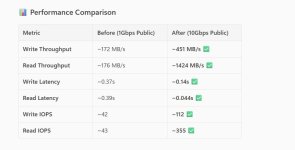Hi all,
I'm running a 3-node Proxmox VE 9 cluster with Ceph and experiencing unexpectedly low performance during rados bench tests. I’d appreciate any insights or suggestions.
and
I get:
Each OSD reports ~525 MB/s throughput with 4MB blocks — so the disks themselves are capable.
Questions:
I'm running a 3-node Proxmox VE 9 cluster with Ceph and experiencing unexpectedly low performance during rados bench tests. I’d appreciate any insights or suggestions.
Cluster Setup:
- Proxmox VE 9 on all nodes
- Ceph Quincy (default in PVE 9)
- 3 nodes: pve01, pve02, pve03
- 1 OSD per node, each on:
- Samsung PM863a SATA SSD (480GB) — SAMSUNG_MZ7L3480HCHQ-00A07
- Dedicated Ceph network using Proxmox SDN fabric
- Nodes are connected in a ring topology via direct 10Gbps DAC
- No separate WAL/DB devices
- Ceph and public networks are separated
Benchmark Results:
Using:
Code:
rados bench -p testbench 60 write --no-cleanupand
Code:
rados bench -p testbench 60 randI get:
- ~172 MB/s write
- ~176 MB/s random read
- ~42–43 IOPS
- ~0.36–0.37s average latency
OSD Bench Results:
Code:
ceph tell osd.* benchiostat Output:
During the benchmark:- sdb (OSD disk) shows only ~7–19% utilization
- CPU is ~99% idle
- Queue depth (aqu-sz) is low (~1.0–1.5)
What I’ve Tried:
- Checked SMART — all SSDs healthy
- Ceph is clean, no recovery/backfill
Questions:
- Is this performance expected for a 3-node, 3-OSD Ceph cluster with SATA SSDs?
- Would adding more OSDs per node significantly improve performance?
- Would separating WAL/DB to NVMe help, even with SATA data devices?
- Any Ceph tuning recommendations for this setup?
- Could the SDN ring topology be a limiting factor?


